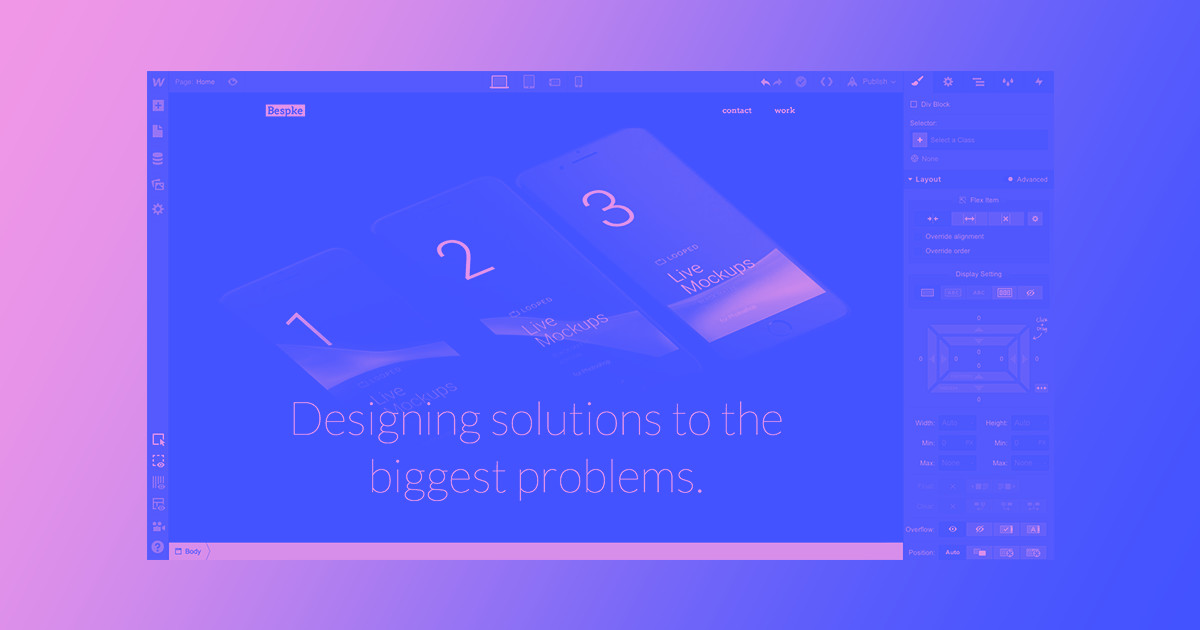In fact, you could say this is where the real work begins. Because for a website to launch successfully — and thrive for years to come — it’ll need a combination of enthusiastic promotion, painstaking analysis, and regular iteration.
If you’re a freelancer, you might typically leave this step to your clients. Totally fair if that’s the nature of your contract. But by guiding and supporting your clients on their website launch, you’ll not only deepen your value to those you serve, but also give them a great reason to keep you on retainer. Which is an excellent way of creating recurring income.
If you’re an in-house designer, on the other hand, chances are your marketing team has these bases covered. But I can personally attest that marketers are pretty much always open to new launch ideas. Plus, they’ll almost certainly be coming to you when they identify opportunities for iterations, tests, and refinements, so you might as well be prepared.
With all that in mind, here are a few tips to help you get the most bang for your upcoming launch.
Consider the “soft” launch
This is the way the [website launches]. Not with a bang but a [whisper].
–Me, paraphrasing T.S. Eliot because it amuses me
Back in 2016, a wine salesman friend of mine invited me to dinner at an San Francisco restaurant called The Progress, sister to the Michelin-starred State Bird Provisions. I knew it was going to be a great experience for numerous reasons, not the least of which is that it’s just how my buddy rolls — but I had no idea what I was in for.
When we walked into the place, it was dead empty. Not a great sign for an SF restaurant, typically.
But then my friend casually tossed over his shoulder: “They’re in soft launch. Friends and family only tonight.”
And suddenly I felt like such a special little snowflake.
Next thing I know, we’re being seated around a long, beautiful, reclaimed wood table. (I know, I know; my eyes are rolling too.) Right beside the restaurateur himself. Who then proceeds to inform us what we’ll be eating. And drinking.
I had such a stupid grin on.
I write this not to humble-brag, but to highlight the power of a “soft” or “beta” or “quiet” launch.
The power of beta
That night at The Progress, I felt in. Like I was suddenly one of the cognoscenti. Rubbing elbows with restaurateurs, food critics, the movers and the shakers.
All an illusion, of course — but a seductive and immersive illusion nonetheless. So powerful that I’m still (obviously) talking about this restaurant. Not only because of the experience itself, but also how epically good the food was. I’ve not darkened their door since, but I know I’ve sent them dozens of customers in my place.
I’m just little ole me. But they turned me into a powerful little marketing machine.
And the good news for those who build for the web is: you can harness this power too.
Create scarcity
The reason that soft/beta launches work so well is that they create a sense of scarcity, turning a typically mundane experience into a rare, sought-after one.
This has three mutually reinforcing effects:
- The haves (those with access) feel acknowledged and/or uplifted — i.e., delighted
- The haves thus want to communicate about this rarefied experience, complementing your other marketing efforts with organic word of mouth
- The have-nots (those without access) suddenly want access even more than before, or for the first time
This is all perhaps best illustrated by the launch of Gmail years ago. I mean, when you think about it, a new email app isn’t exactly what you’d call exciting, right? It’s a utility — a must-have, like electricity.
To make a thing like that exciting, well … you’d need a truly revolutionary design. And/or some artificial scarcity …
Now you may be thinking, “Wait, John. I’m just building a brochure site here. All we’re doing is presenting information. How can we create scarcity for that?”
The answer to that lies beyond the site itself, in the information that you’re presenting. Few sites exist just to present information. And even if that’s all your site does, you’ve got opportunities for the creation of scarcity — so long as the information is new, unique, or even just really high-quality.
Writing an ebook? Give select people early access and ask for blurbs. Presenting study findings? Second verse, same as the first.
And then there’s something you can do for any site type:
Seek feedback
Whether you want to refine your visual or interaction design, clean up your content, or just get user input on your overall UX, you can make good use of your pre-launch planning time by soliciting feedback.
In many ways, this provides the same benefits as creating scarcity. You’re still honoring a few select people and giving them the chance to share their experience with others. And if those people are experts in a field related to your website’s purpose, their sharing can help drum up a little hype for your launch. And if they’re really impressed, you might even get a shining testimonial or two for the site!
But that’s not your purpose for seeking pre-launch feedback. It’s just icing on the cake. The real benefit comes from actually making use of their feedback to improve your website.
And if you do make good use of their input, they’ll likely be even more inclined to give you a supportive shout-out when the real launch begins.
Invite responsibly
One thing to keep in mind for soft launches: don’t just invite anybody. Your Uncle Steve, fun as he’s always been, probably won’t help make your new portfolio launch a splash — unless he’s big in the design world, of course.
Instead, stay focused on your niche. And aim high. Prioritize the people who are most likely to have a big impact, should they choose to comment on or share your new site.
Just don’t be sleazy about it. Steer clear of cold emails, and instead build connections via the various social networks. Of course, a terse “hey @influenceyguy check out [your website here]” will likely get you nowhere. Ditto for jumping on a related thread with a link to your site — unless it truly adds to the conversation.
Build networks first. With a solid network in place, chances are the right people will naturally notice what you’re sharing and choose to share it of their own accord. And even if they don’t, when you later share the site directly, they’ll at least have some context for why.
The web runs on a reputation economy. Ignore that at your own peril.
Skipping the soft launch? Try some teasers!
Even if you’re not going all-in on a soft launch or closed beta, you can start building hype around a (re)launch simply by teasing what’s coming.
You can easily share screenshots of in-progress UI work, offer glimpses of that amazing homepage animation with GIFs, and write positioning statements explaining what you’re working on — and more importantly, why — on Medium. Or any third-party publication in your space.
Launching a new restaurant and its site? Hit up local food writers and magazines. A new web app for editors? Make sure the various Facebook groups for editors know it’s coming.
You get the picture: share enticing content with those likely to enjoy it, and you’ll build hype.



















The modern web design process
Discover the processes and tools behind high-performing websites in this free ebook.
Going public: the official launch
Launch day is, of course, when it’s time to start firing your marketing machine on all cylinders.
If you’re in the tech space, your launch day activities might include, but shouldn’t be limited to:
- Announcement email to all current users — and leads
- Posts on all your various social platforms (Twitter, Facebook, Dribbble, Reddit, etc.) — and seriously consider promoting these to broaden your audience! Also be sure to mention influential individuals and brands who helped out, whether directly or indirectly, such as by providing a testimonial, feedback, etc.
- Posts on aggregator sites like Designer News, Web Designer News, etc.
- Longform publication on your dedicated blog
- Longform publication on Medium (and/or any relevant 3rd-party publications)
- A post on Product Hunt — check out their guide to posting on Product Hunt for detailed info
If you’re not in the tech space, several of the platforms mentioned in the above list may be irrelevant to you. But the web is so sprawling just about any niche community will have its blogs, forums, aggregators, etc., so just plug in the right names and places for you.
Either way, the basic principle still holds: communicate to your audience where they are, in as many ways and places as you can afford to.
But spreading the word isn’t the only thing to worry about on launch day. A few other things to consider:
Fear the crash
All too often, a new product, service, or website will launch to massive fanfare — only to crash in the face of unexpected traffic.
In larger organizations, you can typically count on engineering to cover this concern. With a smaller organization, there’s usually less concern for a crash, but you can always contact your hosting provider for tips and help.
If you’re involved with marketing, you can help defend against crashes by carefully considering announcement timing, and by batching your announcement emails. Tools like MailChimp will automatically give you the option to batch your sends, cutting down the likelihood of millions of visits coming in at once.
Of course, nothing’s perfect, so you’ll want to also have plans in place for dealing with a crash, should it come.
Keep a close eye on performance
Beyond the basic performance metric of uptime, you’ll also want to monitor what people do when they get to your site.
Google Analytics and a host of other tools can provide real-time and after-the-fact data on pages people visited, multi-page flows they explored, even conversion rates — all of which can do a ton to inform all kinds of decisions, from how well your site presents and organizes content, to how well it appeals to your various audiences.
Just keep in mind that the sample data you’ll receive on launch day may be skewed. A massive amount of visits can bring a lot of people who aren’t good fits for your offering, which would negatively impact conversion rates, retention, etc.
So while you may notice things you need to fix ASAP — like that typo on the homepage — other data may need more time to normalize before you make a change.
Keep an even closer eye on public response
Not all data comes through Google Analytics. Some of the most important and telling feedback you’ll receive will come from public tweets, comments on Product Hunt, Facebook conversations, etc.
So take note of what the people are saying — positive and negative — to understand which parts of your messaging, product/service, and design work, and which don’t.
If people seem confused about feature X, revisit the way you message it. If folks seem particularly excited by something you didn’t really highlight in launch content, maybe that aspect needs more limelight.
People may even literally hand you amazing content. I can happily confess that more than one of my best-performing lines of copy came directly from customer’s mouths.
Don’t forget to celebrate
With all of the above said, don’t forget to leave some time for celebration. Those bottles of bubbly aren’t going to drink themselves!
After the launch: on the web, your job is never done
Flash forward to the day after launch: Your champagne hangover — which you can now attest is the worst kind — has faded, and you’re reviewing yesterday’s numbers.
Hopefully, you’re wowed by the response and the effectiveness of all your marketing. You might also be sorely disappointed.
But however you’re reacting to analytics, the important thing is to focus on your next play.
Review your most important metrics
You’ve known since long before launch what metrics you wanted to move. So look all the way back to your project’s goals, defined as the first step in the design process, and take a cold, hard look at how the relaunch affected those numbers.
If you did meet or exceed a goal for a particular metric, congrats! You achieved your goal. Now look for ways to do even better — or alternative goals to consider.
If you didn’t meet or exceed a goal, it’s time to double-down on that goal. Perhaps your hypothesis for how to move the key metric was faulty. Or perhaps it worked, but not as much as you thought it would.
Consider the following hypothetical scenario, where your key metric was conversion rate:
Goal: Increase conversion rate to 15%
Hypothesis: Current email-only signup flow discourages people who don’t want to take the time to complete our onboarding process.
Proposed solution: Add an option to sign up via Facebook. Then use profile info to pre-fill several fields in the onboarding process.
Result: Partial success. Signups improved to 12.5%.
Partial success isn’t the worst thing, but obviously you’ve got room to grow. So start hypothesizing why the addition of Facebook signup didn’t work as expected. At this stage, it’s okay to make some gut checks for possible reasons.
Hypotheses: Facebook signup option not visually obvious enough. Facebook signup seems too invasive. Too many permissions required for Facebook signup. Users want more social signup options. Our biggest audience is actually on Twitter.
Hopefully some of those hypotheses can be dismissed out of hand. For example, if your biggest audience is actually on Twitter, building a Facebook signup option probably didn’t make a lot of sense, right?
Your other hypotheses will probably take some review of available data. Heatmaps should be able to tell you if the Facebook signup option wasn’t obvious enough. An analysis of drop-off points in the signup flow might tell you whether the option itself is unattractive — for instance, if people clicked the “via Facebook” button, but didn’t complete, then maybe you were asking for too much data. If they saw it and didn’t click it, maybe it’s the wrong platform entirely!
In this case, adding the Facebook signup option seems to have worked, at least somewhat. So adding more social signup options might help.
But the data may show that signups increased without significant help from that option. In which case, it’s time to go back to the drawing board to figure out what really helped.
Once you’ve isolated the causes behind changes in key metrics, you can start coming up with design and content tests to address the issues.
If you redesigned, analyze cautiously
Incremental change is better than ambitious failure
–Tony Schwartz
The last point of the previous section highlights a significant issue to keep in mind when reviewing post-launch analytics for redesigns, rebrands, and relaunches.
When you’re starting from scratch, all your data is clean and new. There’s nothing to compare it to — it instead provides the baseline for future testing.
But if your latest launch was triggered by a reinvention of any kind — rebrand, relaunch, redesign — you’ve got some messy data on your hands.
You’ve changed so many things that it’ll basically be impossible to attribute any upticks or downticks to any one element, other than the overhaul itself. It could be that new or revised headline. It could be the revamped signup form. Or it could be all the new elements, working together, in exactly the kind of synergistic harmony you dreamt of.
Thus, choosing to redesign is functionally equivalent to starting from scratch. At least from a data analysis perspective. It either worked or didn’t work, and you won’t really be able to draw any conclusions about why, relative to the previous design.
Iterate, iterate, iterate
Measure twice, cut once
–Your grandpa, probably
Of course, analysis is meaningless without action.
So once you’ve identified the metrics you need to affect, and the changes you think will address those metrics, it’s time to start iterating.
Note: I did not say redesigning.
Because you don’t want to just throw the baby out with the bathwater. Your current design provides a baseline. To understand what will work better or worse than that baseline, you need to create an alternative approach and test the alternative in comparison to that baseline. To do that, create a simple this-or-that test: split your traffic between the two pages, and see if your proposed fix actually does better.
But whyyyyyy, you might be thinking.
And I get it. We’re wired to see problems, then fix them, based on what our gut tells us is “right.”
But let’s say you go ahead and launch your redesigned signup flow and retire the old one. Everything down to your gut tells you the new solution is the way it “should” be.
And the redesign does worse. Gut 0, World 1. Lots ventured, nothing gained.
The stakes aren’t so high on your average landing page, especially if you’re working in Webflow. You can iterate, launch, then revert fairly easy with our version history feature. But if you’re working on a signup flow, chances are that “from the gut” redesign ended up being fairly expensive and brought no return.
So test first, push second. After the results are in.
































